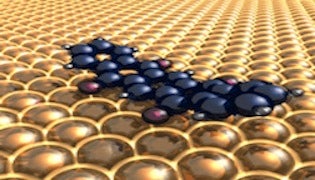Subjects of first-year graduate courses include quantum mechanics, both time-dependent and time-independent, advanced thermodynamics, statistical mechanics, and kinetics. There are advanced elective courses in nanotechnology, group theory, computational chemistry, atmospheric chemistry and aerosols, nonlinear laser spectroscopy, surface science, scanning tunneling microscopy, advanced methods in NMR, and organic electronic materials. Faculty members in the area also have joint appointments in the School of Engineering, the department of Physics, and the Cell Molecular and Developmental Biology interdisciplinary program. The opportunity exists to do interdisciplinary research projects with two or more research advisors. There are weekly seminars at the departmental and area levels, along with meetings within research groups to familiarize students with current topics.
Faculty Research Descriptions:
Christopher Bardeen
The Bardeen Lab uses time-resolved laser spectroscopy and advanced microscopy methods to look at dynamics in complex chemical systems. Areas of research include DNA motion in living cells and energy transport in organic semiconductors.
Ludwig Bartels
The Bartels Group investigates dynamic processes of individual molecules at metal surfaces by means of scanning tunneling microscopy (STM) as well as other techniques (ultra-fast lasers, XPS, etc.). Recent work addressed nanorobots, nanoscale templating and the stability of molectronic structures. This work is funded by NSF and DOE.
In a different project, we investigate the formation, modification and processing of Molybdenum Disulfide (MoS2) and related materials. This project is funded by the NSF and the Semiconductor Research Corporation.
Gregory Beran
We use quantum chemistry to understand and predict chemical properties in molecular and extended systems, and we develop the new theoretical tools that make these calculations possible.
David Bocian
Spectroscopic (vibrational, electronic and magnetic resonance) and electrochemical studies of energy-transducing systems including heme and photosynthetic proteins, synthetic light-harvesting arrays, molecular photonic devices, and electrically addressable molecular memories.
Chia-en Chang
Molecular dynamics in chemical and biological systems: The Chang group primarily uses computational methods to investigate the chemistry of biological systems. The goal is to understand how molecules can bind and how molecular flexibility influences ligand binding, and use the knowledge to design drugs and interpret experiments. We have developed new methods to understand ligand binding kinetics.
James Davies
Our research explores how the physical and chemical properties of aerosol particles and droplets are coupled to their chemical reactivity, particularly for heterogeneous oxidation, photo-chemistry and condensed-phase chemical processes found in the atmosphere. The unique role of the vapor-liquid interface on chemical reactivity is of particular interest.
Ryan Julian
Mass spectrometry, spectroscopy, molecular dynamics, and ab initio calculations are used to examine the sequence, structure, and modification of biomolecules with an emphasis on proteins and peptides. Radical chemistry, supramolecular chemistry, ion-molecule reactions, photodissociation, and collisional activation are frequently employed in these experiments. The primary focus is to obtain a molecular level understanding of chemistry related to life.
Leonard Mueller
Solid-state and solution-state NMR as a probe of structure and dynamics.
Timothy A. Su
Experimental physical chemistry is a major interest in the Su Lab within the context of molecular electronics, a field that explores the notion of using individual molecules as the active components in electronics devices. The Su Lab designs and makes molecules with tailored electronic properties, then wires them between electrodes into single-molecule circuites. Charge transport through these molecular circuites is studied using homebuilt scanning tunneling microscope break-junction (STM-BJ) instrument. This approach enables the lab to explore quantum transport phenomena that occur exclusively at the molecular scale.
Bryan M. Wong
The Wong group develops and applies first-principles, quantum-mechanical computational techniques to predict, understand, and rationally design chemical/material systems (either previously synthesized or yet to be made). Our motivation arises from a deep interest in electron dynamics – a surprisingly rich research area that centers on the non-equilibrium (i.e., time-dependent) electronic properties of systems. Our expertise in developing and applying new electronic structure and time-dependent dynamics techniques brings a new, unique capability for exploring these rich, emerging areas in complex chemical/material systems.
Yadong Yin
The Yin lab explores the chemistry, physics, and materials science of colloidal inorganic nanostructures, with a goal towards applications in catalytic, electronic, photonic and biomedical applications.
Francisco Zaera
Surface chemistry with emphasis on heterogeneous catalysis and materials science; use of several surface sensitive techniques including RAIRS, TPD, XPS, ISS, AES, LEED and SIMS together with molecular beams for kinetic measurements.
Haofei Zhang
the formation and evolution of organic aerosol in the atmosphere. In the long term, we want to understand how organic aerosol impacts climate and human health.
Jingsong Zhang
Studies of elementary photochemical processes and reaction dynamics of small molecules and free radicals in atmospheric chemistry and combustion chemistry, use of laser spectroscopy, mass spectrometry and molecular beam techniques.
Graduate students and postdocs of the Physical Chemistry Program of UCR have moved on to positions at the following companies and institutions (academic positions indicated are permanent or faculty positions). Only a small subset is shown.

